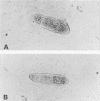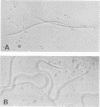Abstract
The effect of the polyamine oxidase (PAO)-polyamine system on some helminths was examined in vitro. Both Schistosoma mansoni schistosomula and Dirofilaria immitis microfilariae were highly sensitive to this system, the latter more so than the former. In contrast, exsheathed third-stage larvae of Nematospiroides dubius were resistant to the effects of the PAO-polyamine system. After incubation of microfilariae with either spermine or spermidine in the presence of serum containing PAO (bovine serum or human retroplacental serum) or partially purified PAO, damage of worms occurred, compatible with our criteria for worm death. Similar results were obtained with schistosomula by using spermine. The damage seemed to be mediated by PAO products other than hydrogen peroxide because catalase did not protect either parasite. Our data demonstrate that helminths may be damaged by products of the PAO-polyamine system.
Full text
PDF




Images in this article
Selected References
These references are in PubMed. This may not be the complete list of references from this article.
- Bout D. T., Joseph M., David J. R., Capron A. R. In vitro killing of S. mansoni schistosomula by lymphokine-activated mouse macrophages. J Immunol. 1981 Jul;127(1):1–5. [PubMed] [Google Scholar]
- Capron A., Dessaint J. P., Capron M., Joseph M., Torpier G. Effector mechanisms of immunity to schistosomes and their regulation. Immunol Rev. 1982;61:41–66. doi: 10.1111/j.1600-065x.1982.tb00373.x. [DOI] [PubMed] [Google Scholar]
- Colley D. G., Wikel S. K. Schistosoma mansoni: simplified method for the production of schistosomules. Exp Parasitol. 1974 Feb;35(1):44–51. doi: 10.1016/0014-4894(74)90005-8. [DOI] [PubMed] [Google Scholar]
- El-Sadr W. M., Aikawa M., Greene B. M. In vitro immune mechanisms associated with clearance of microfilariae of Dirofilaria immitis. J Immunol. 1983 Jan;130(1):428–434. [PubMed] [Google Scholar]
- Ferrante A., Allison A. C., Hirumi H. Polyamine oxidase-mediated killing of African trypanosomes. Parasite Immunol. 1982 Sep;4(5):349–354. doi: 10.1111/j.1365-3024.1982.tb00446.x. [DOI] [PubMed] [Google Scholar]
- Ferrante A., Rzepczyk C. M., Allison A. C. Polyamine oxidase mediates intra-erythrocytic death of Plasmodium falciparum. Trans R Soc Trop Med Hyg. 1983;77(6):789–791. doi: 10.1016/0035-9203(83)90290-0. [DOI] [PubMed] [Google Scholar]
- Ferrante A., Rzepczyk C. M., Saul A. J. Polyamine oxidase-mediated trypanosome killing: the role of hydrogen peroxide and aldehydes. J Immunol. 1984 Oct;133(4):2157–2162. [PubMed] [Google Scholar]
- James E. R., Taylor M. G. Transformation of cercariae to schistosomula: a quantitative comparison of transformation techniques and of infectivity by different injection routes of the organisms produced. J Helminthol. 1976 Dec;50(4):223–233. doi: 10.1017/s0022149x0002664x. [DOI] [PubMed] [Google Scholar]
- Jong E. C., Mahmoud A. A., Klebanoff S. J. Peroxidase-mediated toxicity to schistosomula of Schistosoma mansoni. J Immunol. 1981 Feb;126(2):468–471. [PubMed] [Google Scholar]
- Mahmoud A. A., Peters P. A., Civil R. H., Remington J. S. In vitro killing of schistosomula of Schistosoma mansoni by BCG and C. parvum-activated macrophages. J Immunol. 1979 May;122(5):1655–1657. doi: 10.2196/41502. [DOI] [PMC free article] [PubMed] [Google Scholar]
- Morgan D. M., Illei G. Polyamine-polyamine oxidase interaction: part of maternal protective mechanism against fetal rejection. Br Med J. 1980 May 31;280(6227):1295–1297. doi: 10.1136/bmj.280.6227.1295. [DOI] [PMC free article] [PubMed] [Google Scholar]
- Morgan D. M. Polyamine oxidases. Biochem Soc Trans. 1985 Apr;13(2):322–326. doi: 10.1042/bst0130322. [DOI] [PubMed] [Google Scholar]
- Roelants G. E. Natural resistance to African trypanosomiasis. Parasite Immunol. 1986 Jan;8(1):1–10. doi: 10.1111/j.1365-3024.1986.tb00828.x. [DOI] [PubMed] [Google Scholar]
- Rzepczyk C. M., Bishop C. J. Immunological and ultrastructural aspects of the cell-mediated killing of Dirofilaria immitis microfilariae. Parasite Immunol. 1984 Sep;6(5):443–457. doi: 10.1111/j.1365-3024.1984.tb00815.x. [DOI] [PubMed] [Google Scholar]
- Rzepczyk C. M., Saul A. J., Ferrante A. Polyamine oxidase-mediated intraerythrocytic killing of Plasmodium falciparum: evidence against the role of reactive oxygen metabolites. Infect Immun. 1984 Jan;43(1):238–244. doi: 10.1128/iai.43.1.238-244.1984. [DOI] [PMC free article] [PubMed] [Google Scholar]
- Seiler N., Bolkenius F. N., Knödgen B., Mamont P. Polyamine oxidase in rat tissues. Biochim Biophys Acta. 1980 Oct;615(2):480–488. doi: 10.1016/0005-2744(80)90514-8. [DOI] [PubMed] [Google Scholar]
- Smithers S. R., Terry R. J. The infection of laboratory hosts with cercariae of Schistosoma mansoni and the recovery of the adult worms. Parasitology. 1965 Nov;55(4):695–700. doi: 10.1017/s0031182000086248. [DOI] [PubMed] [Google Scholar]




